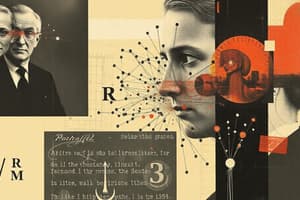Podcast
Questions and Answers
What properties should a valid similarity metric hold?
What properties should a valid similarity metric hold?
- Nonnegativity and symmetry (correct)
- Negativity and symmetry
- Positivity and skewness
- Positivity and symmetry
Is mutual information a valid similarity metric?
Is mutual information a valid similarity metric?
- No, never (correct)
- Yes, only for continuous variables
- Depends on the context
- Yes, always
For which type of variables is the joint distribution tractable?
For which type of variables is the joint distribution tractable?
- Continuous variables
- Categorical variables
- Discrete variables (correct)
- Nominal variables
In the equation given, what does T represent?
In the equation given, what does T represent?
How is the parameter T typically set in mutual information estimation?
How is the parameter T typically set in mutual information estimation?
What type of learning is Deep Graph Infomax associated with?
What type of learning is Deep Graph Infomax associated with?
What is the purpose of standardizing data objects before computing correlation?
What is the purpose of standardizing data objects before computing correlation?
In correlation analysis, what does a correlation value of 0 indicate?
In correlation analysis, what does a correlation value of 0 indicate?
What does the Chi-Square test measure in categorical data analysis?
What does the Chi-Square test measure in categorical data analysis?
How are correlation and causality related in statistical analysis?
How are correlation and causality related in statistical analysis?
What is the significance of a high Chi-Square value in a Chi-Square calculation?
What is the significance of a high Chi-Square value in a Chi-Square calculation?
What does it mean when two variables have a mutual information value of zero?
What does it mean when two variables have a mutual information value of zero?
Which of the following is a key step in standardizing data before applying statistical techniques like correlation analysis?
Which of the following is a key step in standardizing data before applying statistical techniques like correlation analysis?
The chi-square test is commonly used for which of the following purposes?
The chi-square test is commonly used for which of the following purposes?
Which of the following statements about causality is true?
Which of the following statements about causality is true?
The dot product of two vectors is used in which of the following contexts?
The dot product of two vectors is used in which of the following contexts?
Which of the following measures is commonly used to quantify the strength and direction of the linear relationship between two continuous variables?
Which of the following measures is commonly used to quantify the strength and direction of the linear relationship between two continuous variables?
In the context of correlation analysis, which of the following statements is true?
In the context of correlation analysis, which of the following statements is true?
Flashcards are hidden until you start studying
Study Notes
- Attributes can be classified into four types based on their properties: distinctness, order, addition, and multiplication.
- Discrete attributes have a finite or countably infinite set of values, such as zip codes or counts, while continuous attributes have real numbers as values like temperature or weight.
- Central tendency of data can be measured using mean, median, and mode, with the empirical formula relating mean, mode, and median.
- Correlation measures the linear relationship between objects and is computed by standardizing data objects and taking their dot product.
- Mutual information can be used as a loss function, involving joint distributions that are tractable for discrete variables, and can be parameterized using a deep neural network for estimation.
Studying That Suits You
Use AI to generate personalized quizzes and flashcards to suit your learning preferences.




